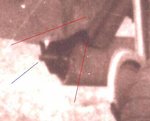- Thread starter
- #61
beaupower32
Tech Sergeant
I found this on another site.A strange Bf 109E... [Archive] - Luftwaffe and Allied Air Forces Discussion Forum
If the device does not show a clear operational benefit to the Bf 109, was it flight testing something for another aircraft design. It was quite common at the time for bits of a proposed aircraft to be attached to other for aerodynamic trials. Someone I hope will recognise the device as a strut of a large aircraft, a proposed 'Mistel' or even a leading edge of a wing / strut etc.
From the HyperScale Plane Talking -forum thread (direct link given earlier by Modeldad).
"William
German Navy used this 109-T for
Mon Jan 24, 2005 17:45
24.67.253.203
Shore battery tests..It is a Naval Smoke Generator, Field fixed to the Airframe."
When asked about source the answer was:
When asked about source the answer was:
"William
Showed this pic to a retired Luftwaffe pilot
Mon Jan 24, 2005 21:48
24.67.253.203
four years ago.(he,s well into his 80,s)..thats what he said it was..the idea was that in case of invasion they wanted to "Obscure" the coastal batteries with smoke thus protecting them from Allied naval guns..If you look at it it will CLICK..could,t have been used at high altitude for anything(its what I told him everybody thought it was)he said way too much drag..its what caused the crash at low landing speed...and for icing trials..well you,d have to get way up there and carry hundeds of gallons of water,no.
The long pipe was just to keep the pilots view clear as he made his low altitude run in front emplacements while smoke poured ot behind him."
Now,
How should we value the statement/message above? Is it genuine?
I think the answer William gives is the most plausible. Ammunition bin storage area within the nose of Bf 109E would provide enough room for smoke agent. For example Piper Pawnee has it's spray tank like that - forward of cockpit. Bf 109 would have provided a fast way to lay smoke screen if emergency arised.
It might interest people that FinnAF did actually fly Bf 109 with smoke generator under belly. This happened post war. I don't know many such flights total was done but one flight was during a mock attack against "enemy" air field during war games. The smoke screen was drawn between AAA guns and the target they protected. That way the Bf 109 JaBos could make their attack more easily. At least that is how I remember it from my reading.
I don't know what the Finnish smoke generator it was - it was just called "can" or somesuch. Captured soviet ones were used with (also captured) SB bombers during the war. It seems the long pipe underneath was not needed, even for the Bf 109.
I wonder if the idea of using Bf 109 as smoke generator plane came from Germany or if it was just result of not much else being available. Planes with interior bomb bay were/are prohibited for FinnAF according the peace agreement of 1948.
If the device does not show a clear operational benefit to the Bf 109, was it flight testing something for another aircraft design. It was quite common at the time for bits of a proposed aircraft to be attached to other for aerodynamic trials. Someone I hope will recognise the device as a strut of a large aircraft, a proposed 'Mistel' or even a leading edge of a wing / strut etc.




![Bf109_with_pipe[4]-1024marked.jpg](/forum/data/attachments/107/107036-42879073ffc1fdc3e1cf694c12873b1b.jpg)
![Bf109_with_pipe[1]-cropped.jpg](/forum/data/attachments/107/107060-77c78cc8d020e9d004a802d49289e63f.jpg)